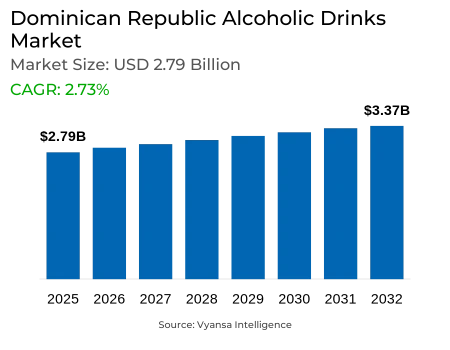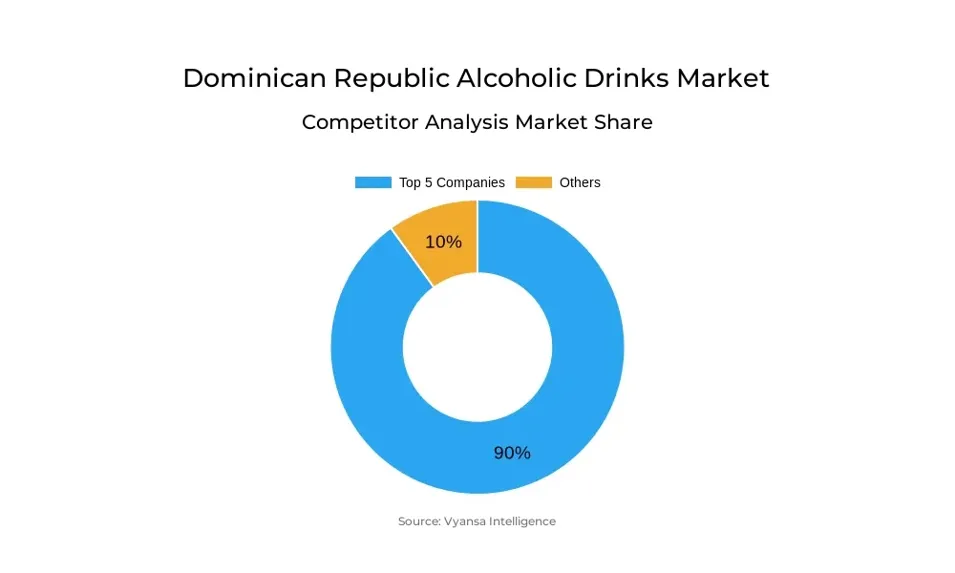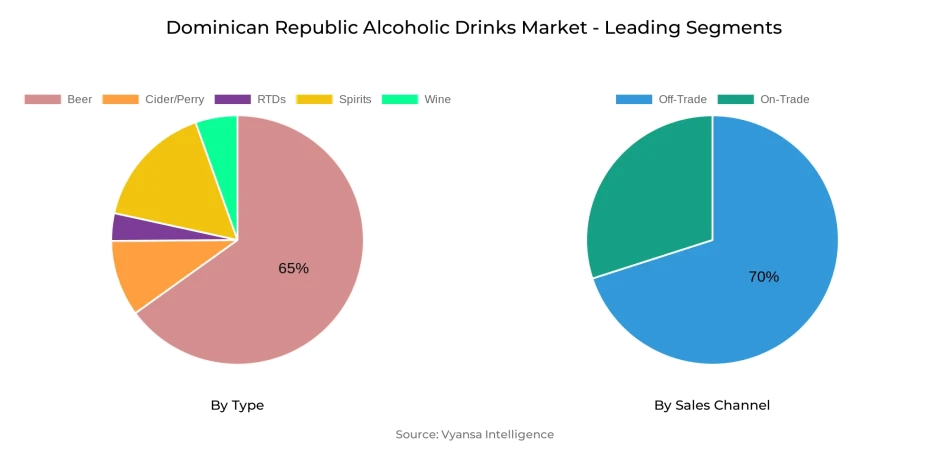
Dominican Republic Alcoholic Drinks Market Report: Trends, Growth and Forecast (2026-2032)
By Type (Beer, Cider/Perry, RTDs, Spirits, Wine), By Alcohol Content (High, Medium, Low), By Flavor (Unflavored, Flavored), By Packaging Type (Glass Bottles, Tins, Plastic Bottles, Others), By Sales Channel (On-Trade, Off-Trade (Retail Offline, Retail Online))
- Food & Beverage
- Nov 2025
- VI0438
- 130
-




Dominican Republic Alcoholic Drinks Market Statistics and Insights, 2026
- Market Size Statistics
- Alcoholic Drinks in Dominican Republic is estimated at $ 2.79 Billion.
- The market size is expected to grow to $ 3.37 Billion by 2032.
- Market to register a CAGR of around 2.73% during 2026-32.
- Type Shares
- Beer grabbed market share of 65%.
- Beer to witness a volume CAGR of around 1.64%.
- Competition
- More than 10 companies are actively engaged in producing Alcoholic Drinks in Dominican Republic.
- Top 5 companies acquired 90% of the market share.
- Molson Coors Brewing Co, Heineken NV, Vinicola del Norte SA, Anheuser-Busch InBev NV, Edrington Group etc., are few of the top companies.
- Sales Channel
- Off-Trade grabbed 70% of the market.
Dominican Republic Alcoholic Drinks Market Outlook
The Dominican Republic Alcoholic Drinks Market is valued at USD 2.79 billion and is likely to increase to USD 3.37 billion by 2032. Moderate volume growth is anticipated during the forecast period on the back of rising tourist visits and end users growing desire for premium and innovative offerings. Beer will be the leading category, with the highest volume sales share, but with moderate growth, a CAGR of approximately 1.64%, to be expected. Beer's refreshing and affordable quality will continue to draw price-conscious shoppers, especially in the summer when it is hot.
Premiumisation will continue to be a driving trend for spirits, rum, whisky, tequila, and wine. end users are becoming increasingly aware of various options and are willing to pay premium prices for better-quality goods, whereas younger end users below 30 years of age will continue to target affordable and lighter alternatives. Ready-to-Drink (RTD) drinks will drive volume growth, led by the low strength, refreshing taste, affordability, and regular flavour extensions. Low-alcohol and non-alcoholic versions, including Corona Cero, will also post solid growth, as end users increasingly embrace health-driven drinking.
Off-trade will still lead the market with approximately 70% of overall sales. Small local supermarkets, colmadones, hypermarkets, and supermarkets will continue to be dominant channels, while online retail will experience growth by way of e-commerce websites and special online promotions. On-trade channels will experience expansion as well, through increased numbers of tourists and the popularity of colmadones and beverage establishments among younger end users and lower-income end users.
Operating conditions will continue to be driven by price sensitivity and smuggling risk, especially among imported spirits. Companies will be oriented towards the trade-off between premium and value-based products to meet the needs of various end users. Product innovation in new rum, whisky, wine, beer, and RTD offerings will continue to drive interest and propel market growth. Overall, the Dominican Republic Alcoholic Drinks Market will experience constant growth in terms of value and premiumisation.

Dominican Republic Alcoholic Drinks Market Growth Driver
Urbanizing Population and Growing Tourism
The rising pace of urbanisation, coupled with growing tourism activities in the Dominican Republic, is significantly boosting the demand for alcoholic drinks. Greater urbanisation results in an increased number of households with disposable income, which fuels the consumption of premium and new alcoholic drinks. Tourists travelling to the nation also play a major role in on-trade consumption, especially in hotels, bars, and resorts, which fuels the introduction of new products and limited releases.
In addition, the increasing presence of restaurants, nightclubs, and pubs in urban areas sustains expansion in the on-trade segment. Locals and tourists alike are demonstrating preference for variety, premium choices, and ready-to-drink products, which further drives market growth. This shift in population, coupled with tourism development, perpetually stimulates the evolution and modernisation of the Alcoholic Drinks Market in the nation.
Dominican Republic Alcoholic Drinks Market Trend
Increased Demand for Premium and Ready-to-Drink Products
A growing shift is being observed among domestic end users in the Dominican Republic, who are increasingly gravitating towards ready-to-drink alcohol and premium spirits. Younger adults end users are drawn to convenience, assortment, and creative flavors from RTDs, which facilitate experimentation and social consumption. Premium beers, spirits, and cocktails are also on the rise as end users look for superior experiences in bars, restaurants, and home parties.
This phenomenon is evident in producers releasing collaborations and limited-edition pieces to stir end users interest. The marriage of convenience, quality, and distinctive flavor fuels the development of the market, with non-alcoholic and low-alcohol variations becoming complementary offerings. This premiumisation and ready-to-drink trend is dictating the future direction of alcoholic drinks in the nation.
Dominican Republic Alcoholic Drinks Market Opportunity
Growth of Non-Alcoholic and Innovative Drinks
The Dominican Republic market for non-alcoholic and new drinks is going to grow, offering huge opportunities for manufacturers. With rising end users concerns for health and wellness, non-alcoholic beers, spirits, and ready-to-drink are going to be in demand. Manufacturers can benefit by launching new flavors, packaging, and premium styles.
Moreover, the channel of on-trade, fueled by tourism and urbanization, opens the doors for the introduction of innovative products, both captivating local end users and tourists. Strategic collaboration, partnerships, and limited-edition releases will continue to consolidate market expansion. Targeting innovation and health-oriented products will help the manufacturers tap new emerging end users bases and fuel future growth for the alcoholic beverages Market.
Dominican Republic Alcoholic Drinks Market Segmentation Analysis

By Type
- Beer
- Cider/Perry
- RTDs
- Spirits
- Wine
The segment with highest market share under Type segment is Beer, which captured approximately 65% of the overall market. Beer is still the drink of choice for alcoholic beverages because of its price, refreshing nature, and easy availability in urban and rural settings. It is still chosen by end users through on-trade as well as off-trade outlets, adding to total volume sales. Brand promotions, tastings, and advertisement campaigns by the major players also confirm its position.
Wine and spirits, such as rum, whisky, and tequila, have lower shares but are witnessing premiumisation trends. Ready-to-Drink drinks (RTDs) are becoming a high-growing category, particularly with younger buyers preferring low-alcohol, flavored, and easy-to-consume drinks. Beer is forecast to experience a modest volume CAGR of about 1.64% during the forecast period, indicating its maturity but ongoing leadership in the market.
By Sales Channel
- On-Trade
- Off-Trade
The segment with highest market share under Sales Channel is Off-Trade, which had a share of approximately 70% of the total market. Small local grocers (colmados), colmadones, supermarkets, and hypermarkets fall under the category of Off-trade, placing alcoholic beverages within easy reach of the majority of the end users populace. Most of these places have on-site consumption facilities, balancing convenience and social interaction.
Online retailing is slowly picking up pace, with online-off-trade value increasing steadily as supermarkets, hypermarkets, and specialists deliver single-serve offers to drive end users into their stores. On-trade channels, including bars, restaurants, and specialty drinks venues, keep expanding, led by rising tourist numbers and higher-income shoppers. Off-trade, nevertheless, is the foundation of the market, particularly for the lower- and middle-income segments, guaranteeing its leading share throughout the forecast period.
Top Companies in Dominican Republic Alcoholic Drinks Market
The top companies operating in the market include Molson Coors Brewing Co, Heineken NV, Vinicola del Norte SA, Anheuser-Busch InBev NV, Edrington Group, Barceló International SA, Diageo Plc, J Armando Bermúdez & Co, C por A, Pernod Ricard Groupe, Bacardi & Co Ltd, etc., are the top players operating in the Dominican Republic Alcoholic Drinks Market.
Frequently Asked Questions
Related Report
1. Market Segmentation
1.1. Research Scope
1.2. Research Methodology
1.3. Definitions and Assumptions
2. Executive Summary
3. Dominican Republic Alcoholic Drinks Market Policies, Regulations, and Standards
4. Dominican Republic Alcoholic Drinks Market Dynamics
4.1. Growth Factors
4.2. Challenges
4.3. Trends
4.4. Opportunities
5. Dominican Republic Alcoholic Drinks Market Statistics, 2022-2032F
5.1. Market Size & Growth Outlook
5.1.1. By Revenues in US$ Million
5.1.2. By Quantity Sold in Million Litres
5.2. Market Segmentation & Growth Outlook
5.2.1. By Type
5.2.1.1. Beer- Market Insights and Forecast 2022-2032, USD Million
5.2.1.2. Cider/Perry- Market Insights and Forecast 2022-2032, USD Million
5.2.1.3. RTDs- Market Insights and Forecast 2022-2032, USD Million
5.2.1.4. Spirits- Market Insights and Forecast 2022-2032, USD Million
5.2.1.5. Wine- Market Insights and Forecast 2022-2032, USD Million
5.2.2. By Alcohol Content
5.2.2.1. High- Market Insights and Forecast 2022-2032, USD Million
5.2.2.2. Medium- Market Insights and Forecast 2022-2032, USD Million
5.2.2.3. Low- Market Insights and Forecast 2022-2032, USD Million
5.2.3. By Flavor
5.2.3.1. Unflavored- Market Insights and Forecast 2022-2032, USD Million
5.2.3.2. Flavored- Market Insights and Forecast 2022-2032, USD Million
5.2.4. By Packaging Type
5.2.4.1. Glass Bottles- Market Insights and Forecast 2022-2032, USD Million
5.2.4.2. Tins- Market Insights and Forecast 2022-2032, USD Million
5.2.4.3. Plastic Bottles- Market Insights and Forecast 2022-2032, USD Million
5.2.4.4. Others- Market Insights and Forecast 2022-2032, USD Million
5.2.5. By Sales Channel
5.2.5.1. On-Trade- Market Insights and Forecast 2022-2032, USD Million
5.2.5.2. Off-Trade- Market Insights and Forecast 2022-2032, USD Million
5.2.5.2.1. Retail Offline- Market Insights and Forecast 2022-2032, USD Million
5.2.5.2.2. Retail Online- Market Insights and Forecast 2022-2032, USD Million
5.2.6. By Competitors
5.2.6.1. Competition Characteristics
5.2.6.2. Market Share & Analysis
6. Dominican Republic Beer Market Statistics, 2022-2032F
6.1. Market Size & Growth Outlook
6.1.1. By Revenues in US$ Million
6.1.2. By Quantity Sold in Million Litres
6.2. Market Segmentation & Growth Outlook
6.2.1. By Alcohol Content- Market Insights and Forecast 2022-2032, USD Million
6.2.2. By Flavor- Market Insights and Forecast 2022-2032, USD Million
6.2.3. By Packaging Type- Market Insights and Forecast 2022-2032, USD Million
6.2.4. By Sales Channel- Market Insights and Forecast 2022-2032, USD Million
7. Dominican Republic Cider/Perry Market Statistics, 2022-2032F
7.1. Market Size & Growth Outlook
7.1.1. By Revenues in US$ Million
7.1.2. By Quantity Sold in Million Litres
7.2. Market Segmentation & Growth Outlook
7.2.1. By Alcohol Content- Market Insights and Forecast 2022-2032, USD Million
7.2.2. By Flavor- Market Insights and Forecast 2022-2032, USD Million
7.2.3. By Packaging Type- Market Insights and Forecast 2022-2032, USD Million
7.2.4. By Sales Channel- Market Insights and Forecast 2022-2032, USD Million
8. Dominican Republic Ready-to-Drink Market Statistics, 2022-2032F
8.1. Market Size & Growth Outlook
8.1.1. By Revenues in US$ Million
8.1.2. By Quantity Sold in Million Litres
8.2. Market Segmentation & Growth Outlook
8.2.1. By Alcohol Content- Market Insights and Forecast 2022-2032, USD Million
8.2.2. By Flavor- Market Insights and Forecast 2022-2032, USD Million
8.2.3. By Packaging Type- Market Insights and Forecast 2022-2032, USD Million
8.2.4. By Sales Channel- Market Insights and Forecast 2022-2032, USD Million
9. Dominican Republic Spirits Market Statistics, 2022-2032F
9.1. Market Size & Growth Outlook
9.1.1. By Revenues in US$ Million
9.1.2. By Quantity Sold in Million Litres
9.2. Market Segmentation & Growth Outlook
9.2.1. By Alcohol Content- Market Insights and Forecast 2022-2032, USD Million
9.2.2. By Flavor- Market Insights and Forecast 2022-2032, USD Million
9.2.3. By Packaging Type- Market Insights and Forecast 2022-2032, USD Million
9.2.4. By Sales Channel- Market Insights and Forecast 2022-2032, USD Million
10. Dominican Republic Wine Market Statistics, 2022-2032F
10.1.Market Size & Growth Outlook
10.1.1. By Revenues in US$ Million
10.1.2. By Quantity Sold in Million Litres
10.2.Market Segmentation & Growth Outlook
10.2.1. By Alcohol Content- Market Insights and Forecast 2022-2032, USD Million
10.2.2. By Flavor- Market Insights and Forecast 2022-2032, USD Million
10.2.3. By Packaging Type- Market Insights and Forecast 2022-2032, USD Million
10.2.4. By Sales Channel- Market Insights and Forecast 2022-2032, USD Million
11. Competitive Outlook
11.1.Company Profiles
11.1.1. Anheuser-Busch InBev NV
11.1.1.1. Business Description
11.1.1.2. Product Portfolio
11.1.1.3. Collaborations & Alliances
11.1.1.4. Recent Developments
11.1.1.5. Financial Details
11.1.1.6. Others
11.1.2. Edrington Group
11.1.2.1. Business Description
11.1.2.2. Product Portfolio
11.1.2.3. Collaborations & Alliances
11.1.2.4. Recent Developments
11.1.2.5. Financial Details
11.1.2.6. Others
11.1.3. Barceló International SA
11.1.3.1. Business Description
11.1.3.2. Product Portfolio
11.1.3.3. Collaborations & Alliances
11.1.3.4. Recent Developments
11.1.3.5. Financial Details
11.1.3.6. Others
11.1.4. Diageo Plc
11.1.4.1. Business Description
11.1.4.2. Product Portfolio
11.1.4.3. Collaborations & Alliances
11.1.4.4. Recent Developments
11.1.4.5. Financial Details
11.1.4.6. Others
11.1.5. J Armando Bermúdez & Co, C por A
11.1.5.1. Business Description
11.1.5.2. Product Portfolio
11.1.5.3. Collaborations & Alliances
11.1.5.4. Recent Developments
11.1.5.5. Financial Details
11.1.5.6. Others
11.1.6. Molson Coors Brewing Co
11.1.6.1. Business Description
11.1.6.2. Product Portfolio
11.1.6.3. Collaborations & Alliances
11.1.6.4. Recent Developments
11.1.6.5. Financial Details
11.1.6.6. Others
11.1.7. Heineken NV
11.1.7.1. Business Description
11.1.7.2. Product Portfolio
11.1.7.3. Collaborations & Alliances
11.1.7.4. Recent Developments
11.1.7.5. Financial Details
11.1.7.6. Others
11.1.8. Vinicola del Norte SA
11.1.8.1. Business Description
11.1.8.2. Product Portfolio
11.1.8.3. Collaborations & Alliances
11.1.8.4. Recent Developments
11.1.8.5. Financial Details
11.1.8.6. Others
11.1.9. Pernod Ricard Groupe
11.1.9.1. Business Description
11.1.9.2. Product Portfolio
11.1.9.3. Collaborations & Alliances
11.1.9.4. Recent Developments
11.1.9.5. Financial Details
11.1.9.6. Others
11.1.10. Bacardi & Co Ltd
11.1.10.1. Business Description
11.1.10.2. Product Portfolio
11.1.10.3. Collaborations & Alliances
11.1.10.4. Recent Developments
11.1.10.5. Financial Details
11.1.10.6. Others
12. Disclaimer
| Segment | Sub-Segment |
|---|---|
| By Type |
|
| By Alcohol Content |
|
| By Flavor |
|
| By Packaging Type |
|
| By Sales Channel |
|
Research Methodology
This study followed a structured approach comprising four key phases to assess the size and scope of the electro-oxidation market. The process began with thorough secondary research to collect data on the target market, related markets, and broader industry context. These findings, along with preliminary assumptions and estimates, were then validated through extensive primary research involving industry experts from across the value chain. To calculate the overall market size, both top-down and bottom-up methodologies were employed. Finally, market segmentation and data triangulation techniques were applied to refine and validate segment-level estimations.
Secondary Research
The secondary research phase involved gathering data from a wide range of credible and published sources. This step helped in identifying industry trends, defining market segmentation, and understanding the market landscape and value chain.
Sources consulted during this phase included:
- Company annual reports, investor presentations, and press releases
- Industry white papers and certified publications
- Trade directories and market-recognized databases
- Articles from authoritative authors and reputable journals
- Gold and silver standard websites
Secondary research was critical in mapping out the industry's value chain and monetary flow, identifying key market segments, understanding regional variations, and tracking significant industry developments.
Other key sources:
- Financial disclosures
- Industry associations and trade bodies
- News outlets and business magazines
- Academic journals and research studies
- Paid industry databases
Primary Research
To validate secondary data and gain deeper market insights, primary research was conducted with key stakeholders across both the supply and demand sides of the market.
On the demand side, participants included decision-makers and influencers from end-user industries—such as CIOs, CTOs, and CSOs—who provided first-hand perspectives on market needs, product usage, and future expectations.
On the supply side, interviews were conducted with manufacturers, industry associations, and institutional participants to gather insights into current offerings, product pipelines, and market challenges.
Primary interviews provided critical inputs such as:
- Market size and revenue data
- Product and service breakdowns
- Market forecasts
- Regional and application-specific trends
Stakeholders consulted included:
- Leading OEM and solution providers
- Channel and distribution partners
- End users across various applications
- Independent consultants and industry specialists
Market Size Estimation and Data Triangulation
- Identifying Key Market Participants (Secondary Research)
- Goal: To identify the major players or companies in the target market. This typically involves using publicly available data sources such as industry reports, market research publications, and financial statements of companies.
- Tools: Reports from firms like Gartner, Forrester, Euromonitor, Statista, IBISWorld, and others. Public financial statements, news articles, and press releases from top market players.
- Extracting Earnings of Key Market Participants
- Goal: To estimate the earnings generated from the product or service being analyzed. This step helps in understanding the revenue potential of each market player in a specific geography.
- Methods: Earnings data can be gathered from:
- Publicly available financial reports (for listed companies).
- Interviews and primary data sources from professionals, such as Directors, VPs, SVPs, etc. This is especially useful for understanding more nuanced, internal data that isn't publicly disclosed.
- Annual reports and investor presentations of key players.
- Data Collation and Development of a Relevant Data Model
- Goal: To collate inputs from both primary and secondary sources into a structured, data-driven model for market estimation. This model will incorporate key market KPIs and any independent variables relevant to the market.
- Key KPIs: These could include:
- Market size, growth rate, and demand drivers.
- Industry-specific metrics like market share, average revenue per customer (ARPC), or average deal size.
- External variables, such as economic growth rates, inflation rates, or commodity prices, that could affect the market.
- Data Modeling: Based on this data, the market forecasts are developed for the next 5 years. A combination of trend analysis, scenario modeling, and statistical regression might be used to generate projections.
- Scenario Analysis
- Goal: To test different assumptions and validate how sensitive the market is to changes in key variables (e.g., market demand, regulatory changes, technological disruptions).
- Types of Scenarios:
- Base Case: Based on current assumptions and historical data.
- Best-Case Scenario: Assuming favorable market conditions, regulatory environments, and technological advancements.
- Worst-Case Scenario: Accounting for adverse factors, such as economic downturns, stricter regulations, or unexpected disruptions.
Partnering With Industry Leaders to Drive Growth
Our mission is to deliver intelligence that matters. By combining data, analysis, and industry expertise, we enable organizations to make smarter, faster, and more impactful decisions. Whether it’s a Fortune 500 company or a high-growth startup, businesses trust us to provide clarity in an ever-evolving marketplace.






